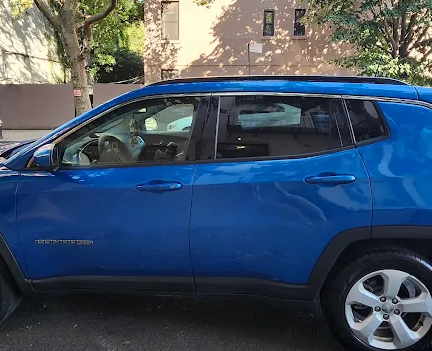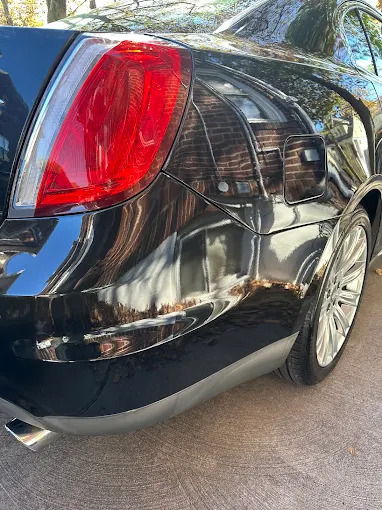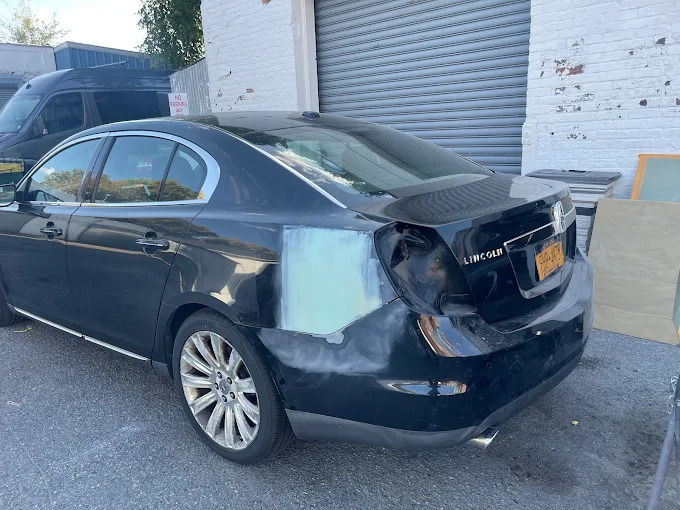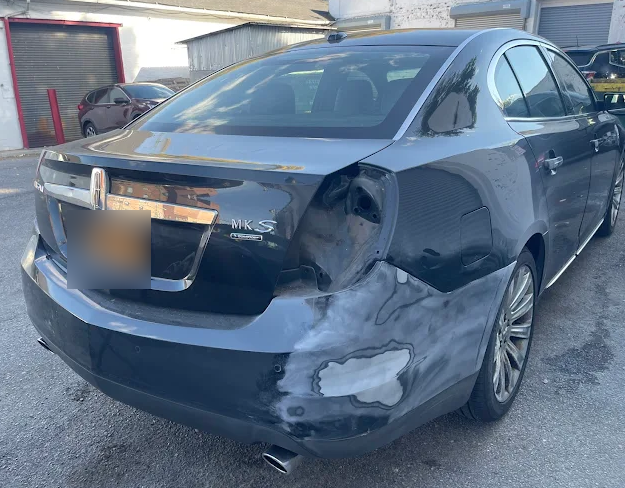Minor dents and dings (paintless dent repair)
Small dents from parking mishaps or cart taps are often prime candidates for paint-free methods when the finish isn’t broken. Skilled techs gently work from behind the panel or use glue tabs from the outside to massage the metal back to its original contour. This is quick, keeps factory paint intact, and usually costs less than sanding and repainting. If the dent has sharp edges, stretched metal, or chipped paint, a conventional approach—shaping, smoothing, priming, and repainting—delivers better results. Location matters too; areas with solid access behind the panel tend to repair more cleanly than braced sections or tight corners.
Hail damage (massaging and panel access)
A hailstorm can pepper hoods, roofs, and trunks with dozens of shallow impressions. When the finish is intact and the dents are smooth, paint-free methods can restore panels with minimal downtime. Techs plan access points carefully, sometimes removing headliners or trim to reach the back side. If some dents are too sharp or the paint is fractured, a blended approach is used, repairing most impressions without repainting and refinishing only the tougher spots. For extremely dense impacts or stretched roof skins, replacing the panel may be faster and yield a cleaner, more durable outcome.

Crease dents vs. soft dents (repair complexity)
Not all dents are created equal. Soft, round depressions tend to move predictably and come out cleanly. Creases, however, concentrate stress along a line and can stretch metal, making the return to a crisp surface trickier. These often require more time and careful reshaping, and they’re more likely to need sanding and refinishing to erase micro-waves. The position of the crease—near a body line, edge, or reinforcement—also affects difficulty. A thoughtful repair plan balances time, cost, and finish quality so the final result looks right from every angle and in strong light.
Scratches, chips, and scuffs (color matching and blending)
Light scuffs that haven’t cut into color can often be polished out, restoring gloss. Stone chips and deeper scratches need preparation, filling as needed, primer, and color that matches the vehicle’s original formula. Because colors age and vary by panel, shops blend adjacent sections to make the transition invisible. The goal is a seamless surface that looks natural in daylight and under shop lights. On plastic parts, some scratches appear worse than they are; a thorough cleaning and polish may surprise you before more involved work is considered.
Clear coat failure and oxidation (refinishing options)
Sun, heat, and age can make the clear layer peel or turn chalky. Once clear coat fails, the fix is more than a quick buff. The damaged layer must be removed in the affected area, the base color evaluated, and a new protective layer applied and blended. If the color coat beneath has also broken down, the shop will refinish that area too. Modern waterborne systems and low‑VOC processes deliver durable, glossy finishes while meeting environmental standards. Proper curing and polishing bring back depth so panels match the rest of the vehicle.
Bumper repair and replacement (plastic welding and sensors)
Bumper covers take the brunt of low‑speed hits. Shallow scrapes and small indents can be reshaped and refinished on plastic covers with the right heat and filler techniques. Cracks, torn tabs, or distortion around grille openings usually call for replacing the cover to ensure a snug fit. Many cover house sensors and trim; these need careful transfer and post-repair checks. If energy‑absorbing parts behind the cover are crushed, those are replaced to keep future protection intact. A good fit around the headlights and fenders is the sign of a job done right.
Door, fender, and quarter panel damage (panel replacement)
Side impacts and parking lot scrapes commonly affect doors and fenders. Localized issues can be straightened and finished cleanly, but panels with torn metal, stretched crown areas, or heavy warping often make more sense to replace. Rear quarter panels, which are welded to the body, may be sectioned with precise cuts to preserve structure while renewing the outer skin. Proper seam sealing and corrosion protection inside the repair are essential so rust doesn’t creep back later. Alignment of gaps and consistent body lines across panels are the visual checkpoints.
Frame straightening and unibody alignment (measurement systems)
Modern vehicles use a unified structure that depends on exact geometry to drive and protect properly. After a hit, a measurement system compares key points on the body to known specs. If there’s deviation, controlled pulling brings the structure back into alignment. This isn’t guesswork—clamping, pulling, and re‑measuring continue until the numbers and the gaps tell the same story. Straight alignment helps doors close smoothly, wheels track correctly, and safety features work as designed. If structural sections are kinked or torn, replacing those pieces can restore integrity better than trying to pull them out.
Auto glass repair and replacement (chip vs. crack)
Glass chips caught early can often be stabilized with a clear resin that restores strength and improves appearance. Long cracks, edge damage, or multiple impact points call for a new pane. Today’s windshields often host cameras and sensors; proper installation keeps those areas clean and distortion‑free so systems see the road correctly. Side and rear glass have different behaviors—some shatter into many small pieces by design—so the repair path depends on glass type and damage location. Clean seals and correct molding fit prevent wind noise and water leaks afterward.
Rust repair (corrosion treatment and cut-and-weld)
Surface rust that hasn’t eaten through can be stopped by removing the oxidized layer, treating the metal, and sealing it under fresh coatings. When corrosion perforates a panel, the lasting fix is to remove the affected metal and install sound material. Hidden rust often lurks behind wheel arches, rocker panels, and seams, so a careful inspection matters. After welding, seam seal, cavity wax, and proper coatings keep moisture out. Shortcuts here come back fast; the best repairs address both what you see and what you don’t.

Aluminum and high‑strength steel repair (special tools)
Many hoods, doors, and structural parts use advanced materials that behave differently under stress. Aluminum doesn’t “remember” its shape the same way and needs cleaner workspaces to avoid contamination. Strong steel grades resist stretching and spring back more, changing how technicians move metal. Dedicated tools, temperatures, and joining methods keep these materials within safe limits. When in doubt, replacing a section with the correct grade ensures the part performs the way the maker intended in everyday driving and, if needed, during a crash.
EV body work considerations (battery isolation and materials)
Electric vehicles introduce shop safety steps and material mixes that call for a steady hand. Before any pull or weld, the high‑voltage system is secured according to maker guidance, protecting both the car and the team. Many EVs carry more aluminum and composites, and weight distribution can change how damage looks versus how deep it goes. Cooling lines, battery enclosures, and underbody shields sometimes sit near impact zones, so inspections go beyond the surface. The right process keeps range, safety, and warranty concerns in check.
ADAS calibration after collision (radar, camera, lidar)
Modern driver aids rely on precise angles and clear views. After a collision, even small shifts can throw off the readings. Once panels are straight and parts are reinstalled, a calibration step centers sensors and cameras so features like lane guidance and braking support act when and how they should. Some checks happen in the shop with targets; others require specific road conditions. Skipping this step can lead to warning lights, odd behavior, or features that don’t engage, so it’s built into the plan when work touches these systems.
OEM parts vs. aftermarket vs. recycled (fit, safety, cost)
There are three common parts choices. New parts from the maker match the original in fit and function and often carry strong backing. Aftermarket parts can save money but may need extra fitting or lack certain features. Recycled components from similar vehicles provide an eco‑friendly, cost‑effective option for non‑structural areas. The choice depends on location, importance to safety systems, availability, and insurance rules. Good shops explain tradeoffs clearly so you can choose what makes sense for your vehicle and budget.
Repair vs. replace thresholds (structural and economic)
A repair makes sense when the result will be durable, safe, and visually clean. Replacement shines when metal is torn, creased deeply, or rust has weakened the area, or when labor to fix would cost more than swapping the part. For structure, kinked parts and compromised joints are red flags. On the financial side, insurers look at the value of the vehicle versus the total repair bill to decide if it should be fixed or declared not economical to restore. The aim is always a safe, lasting outcome rather than a quick patch.
Insurance claims and DRP networks (estimates and rights)
Filing a claim introduces timelines, approvals, and sometimes network suggestions. You generally choose where to fix your car, even if your carrier recommends a partner shop. Direct‑repair networks can speed approvals and rental arrangements, but independent shops also deliver excellent results and can work with your adjuster. Provide clear photos, the incident report if available, and past repair records for smoother processing. Ask for a repair plan that lists steps from start to finish so expectations are set early.
How to choose a body shop (I‑CAR Gold Class, ASE)
Look for training, equipment, and communication. Certifications from respected programs show a commitment to current methods. Shops that invest in measuring systems, welding stations for modern materials, and clean refinish areas are set up for success. Clear explanations, written estimates, and updates during the job build trust. If your vehicle has advanced safety features or is an EV, confirm the shop’s experience with those systems.
Costs, timelines, and warranties (what to expect)
Prices depend on labor hours, parts choices, and how much refinish is needed. Small tasks can wrap up quickly, while larger structural work and special calibrations add time. Parts availability affects scheduling—some components are stocked locally, others need lead time. Many shops warranty their craftsmanship and paint against defects for a set period, and parts carry their own backing. Get these promises in writing, including what’s covered and how to make a claim in the rare case something needs attention later.
2025 trends: AI estimates, parts supply, recalibration
Digital tools continue to speed up early estimates by scanning photos and flagging likely repair lines. While helpful for triage, a hands‑on inspection still confirms hidden issues and safety steps. Parts supply has generally stabilized compared to recent years, though specialty items and certain sensors can still create delays. The biggest growth area is system checks and recalibrations, now a routine part of many jobs as vehicles add more technology. Expect more mobile and in‑house services focused on these final verification steps.
Local laws and consumer rights (state rules and standards)
Rules vary by state and province, but you often have the right to choose your repairer, receive a written estimate, and get notice before any major change in cost. Some regions outline how alternative parts are disclosed, and many require clear invoicing that distinguishes labor, parts, and sublet services. If a dispute arises, state insurance departments or consumer protection offices provide guidance. Keeping all documents—from the estimate to the final bill—helps if you need to ask for adjustments.

Preventing future body damage (maintenance and parking tips)
A few habits go a long way. Wash and seal the finish regularly so contaminants don’t etch into the surface. Fix chips early to keep moisture from creeping under the coating. Park away from tight cart corrals and under cover during storm seasons when possible. Keep a safe following distance to reduce rock strikes. Simple things like opening doors gently near walls and minding curb heights protect edges and lower fascias. Over time, these choices save money and keep your vehicle looking sharp.
How to get an accurate estimate (step‑by‑step)
- Document the damage: Take clear photos from multiple angles and distances, including the whole panel and close‑ups.
- Share context: Describe how it happened, any noises afterward, and warning lights or odd behavior since.
- Provide vehicle details: VIN, build options, mileage, and any previous repairs on the same area.
- Book an in‑person check: Photo estimates are a start, but a thorough inspection finds hidden issues.
- Review the plan: Ask for a written breakdown of steps, parts choices, system checks, and timelines.
- Confirm quality steps: Look for mentions of blending, corrosion protection, and final system verifications.
- Align on updates: Decide how you’ll be notified about progress and any changes before work begins.
FAQs
What types of auto body damage can be repaired for minor dents and dings?
Small, shallow dents without broken finish are often returned to shape quickly, especially when there’s good access behind the panel and the metal isn’t stretched.
What types of auto body damage can be repaired after a hailstorm?
Smooth impressions across hoods and roofs are frequently restored, with more severe or sharp marks addressed individually or, if needed, by replacing a panel.
What types of auto body damage can be repaired on bumpers with scuffs or small cracks?
Surface marks and slight distortions are commonly fixed, while larger cracks or torn mounting points usually call for a new cover to ensure a snug, safe fit.
What types of auto body damage can be repaired if the frame is slightly out of spec?
Many alignment issues can be corrected by measured straightening, with replacement reserved for kinked or torn sections that won’t return to safe geometry.
What types of auto body damage can be repaired when rust is starting?
Early surface spots are removed and sealed; holes or deep decay require cutting out weakened areas and installing solid material to stop the spread.
What types of auto body damage can be repaired on glass with chips or short cracks?
Small chips are often stabilized and made clearer, but long, growing, or edge‑touching cracks typically mean the glass should be replaced.
What types of auto body damage can be repaired on vehicles with advanced safety features?
Many physical issues are fixable, and added system checks afterward make sure cameras and sensors are aimed and functioning correctly.
What types of auto body damage can be repaired on aluminum body panels?
Localized marks and minor deformations can be addressed with the right tools and cleanliness; severe stretching or tears may be better solved by panel replacement.
Conclusion
Most everyday problems—from door dings to scuffed corners, windshields with tiny pits, and even many alignment issues—can be restored to safe, clean condition. The decision to fix or swap parts depends on depth, location, materials, and whether safety tech needs checks afterward. For the best outcome, pair clear documentation with a shop that explains the plan, uses current methods, and verifies systems before delivery. Ready to bring your vehicle back to form? Get a Free Estimate, Book Consultation, or Call Now to schedule an inspection and repair plan that fits your timeline.
